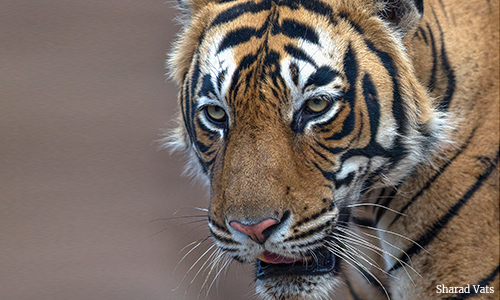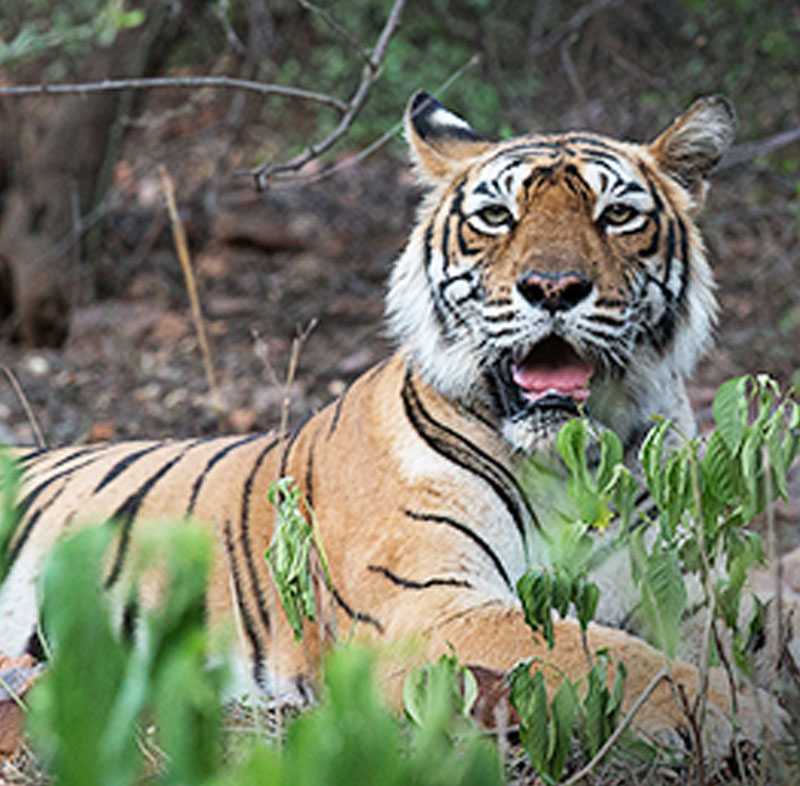The dry deciduous forests of Ranthambore, interspersed by some of India’s largest and oldest Banyan trees, evoke a whimsical sense of romance. These were once the hunting grounds of the famed Maharajas of Jaipur, and even today, vestiges of its royal past remain hidden within its jungle. Scrubby foliage and thorny brush open out onto expansive tracts of grassland, which make up this beautiful wilderness. An ancient fortress lies at the top of a hill, while the crumbling walls of the erstwhile hunting hideouts overlook the river that flows swiftly beneath.
Nestled within the Aravalli mountain range, it has over 500 species of plants and is a thriving ecosystem. Ranthambore is teeming with wildlife and is one of the best-known parks for tigers. They have created a home for themselves in these forests and several generations coexist with one another. The park is also full of other species of flora and fauna, particularly deer, primates, birds and crocodiles.

Ranthambore is situated in the east of Rajasthan, a few of hours south of Jaipur.

Topography: The park is a dry deciduous forest, with plenty of water bodies running through the dense foliage. Open meadow like grasslands break up the forested landscape and hilly terrain.
In Season: The park is open from…
01 October – 30 June
Note: The park is closed to tourists on Wednesday afternoons as well as all day for the Diwali and Holi holidays.
Ranthambore is one of the main tiger conservation reserves in India and was a keystone park for Project Tiger. It’s also known for its large number of Mugger (marsh crocodiles).
Ranthambore’s primary predator is the tiger. These erstwhile hunting grounds of the Maharajas have now become prime territory for big cats. Many tigers have bred successfully with one another and one aspect of Ranthambore’s charm is that it has some of the oldest tigers in the country, as well as some of the youngest. The tiger population grows at a healthy pace as several cubs continue to be born each season. Leopards, crocodiles and sloth bears make up the rest of the large predators. Smaller include jungle cats, jackals, hyenas and foxes, which feed themselves on an abundant prey base of smaller rodents and creatures.
Ranthambore has a large population of herbivores including Cheetal (Spotted Deer), Sambhar, Nilgai (Indian Antelope), and Chinkara (Indian gazelle). It also has several species of monkeys, who run rampant around the ruins of the ancient fortifications and the old temples that lie within the park. You can hear their hoots and calls from miles away and they are the eyes and ears of the forest that warn against the imminent threat of an approaching predator. Ranthambore is also full of bats, which find a convenient resting place amid the crevices of the landscape. The Indian Flying Fox, known for its enormous wingspan, is native to this forest.
Many species of birds find a roost in Ranthambore. In fact, its peacocks are truly majestic, a sight to behold, especially when they perch on the architectural ruins that dot the landscape. Over two hundred species of birds have been recorded, both resident and migratory. The parks many water bodies draw a large number of birds to their banks. Water birds like pelicans, storks, ibises and cormorants are often seen, especially in the winter season. Kingfishers, bulbuls, parakeets, bee-eaters and hornbills can be spotted all across the park, making it a bird-lover’s delight. Ranthambore also has a large population of raptors. One often finds owls, eagles, falcons, kites and shikras circling over the treetops waiting to swoop down on unsuspecting prey.
The nearest airport is at:
The nearest railway stations are at:

Game drives by jeep – you can opt to book your own jeep or share with other passengers.

November to February are the best times weatherwise.
Tiger sightings are excellent in March, April, and May but the temperatures can be very high during these months of the year.
Winters in Ranthambore i.e. November to early February can be very cold. Rajasthan is primarily a desert and while Ranthambore is not in the desert region, temperatures plummet very low and it can get very dry. The summer on the other hand is extremely hot. It’s a very dry heat and temperatures can soar well beyond 40 degrees Celsius (over 100 degrees Fahrenheit). The park is closed during the monsoon season as this is when the animals breed. It usually lasts from early July all the way through till mid-September.
The Oberoi Vanya Vilas –
What we love…This is one of Oberoi’s signature vilas properties and the service is seamless and exquisite.
Aman –
I – Khas – What we love… one of the two Aman properties in India, Aman-I-Khas offers an incredible sense of peace and tranquilty.
Vivanta by Taj Sawai Madhopur Lodge –
What we love… the former hunting lodge of the Maharaja of Jaipur, it’s charm is amplified by its Art Deco aesthetic.
TKhem Vilas –
What we love… the ethos that underscores the entire stay experience is grounded in an earthy, eco-friendly approach with a very strong emphasis on conservation and sustainability.
Dev Vilas
What we love…the thoughtfulness of the accommodations’ design. Each room has two bathrooms so that couples don’t have to wake up extra early for those early morning game drives, and public areas are wheelchair accessible.
Nahargarh –
What we love…the old world Rajput ambience. Nahargarh is built to resemble a palace, with a Mughal garden to match.
Tiger Den Resort –
What we love…evening sessions with their naturalists who regale you with terrific stories and adventures in Ranathambore
Pugmark –
What we love… simple, clean lines, warm service and an underlying philosophy of responsible tourism.
Ranthambore Kothi…What we love…charming bungalow style accommodations evoke an old world British era ambience. Showers that are open to the sky, give it a natural feel.
The months of April and May are considered best for Tiger sightings here, but are also the hottest in this region. Temperatures in May rise to 45 degree centigrade and above, but the frequency of sightings are more than sufficient rewards. There are ten zones in the park where tourism is conducted. Zones 1 to 5 are closer to where the lodges are situated while zones 6 to 10 are further away. The jeep safaris sell out quickly and we highly recommend booking well in advance.